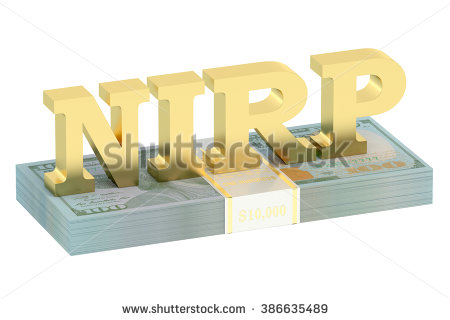
Negative Interest Rate

What is Negative Interest Rate?
DEFINITION of 'Negative Interest Rate Policy (NIRP)'
A negative interest rate policy (NIRP) is an unconventional monetary policy tool whereby nominal target interest rates are set with a negative value, below the theoretical lower bound of zero percent.
A negative interest rate means the Central Bank and perhaps private banks will charge negative interest: instead of receiving money on deposits, depositors must pay regularly to keep their money with the bank.
This is intended to incentivize banks to lend money more freely and businesses and individuals to invest, lend, and spend money rather than pay a fee to keep it safe.
BREAKING DOWN 'Negative Interest Rate Policy (NIRP)'
During deflationary periods, people and businesses hoard money instead of spending and investing. The result is a collapse in aggregate demand which leads to prices falling even farther, a slowdown or halt in real production and output, and an increase in unemployment. A loose or expansionary monetary policy is usually employed to deal with such economic stagnation. However, if deflationary forces are strong enough, simply cutting the central bank's interest rate to zero may not be sufficient to stimulate borrowing and lending. (See also: How Interest Rates Can Go Negative.)
A negative interest rate means the central bank and perhaps private banks will charge negative interest: instead of receiving money on deposits, depositors must pay regularly to keep their money with the bank. This is intended to incentivize banks to lend money more freely and businesses and individuals to invest, lend, and spend money rather than pay a fee to keep it safe.
Examples
An example of a negative interest rate policy would be to set the key rate at – 0.2%, such that bank depositors would have to pay two-tenths of a percent on their deposits instead of receiving any sort of positive interest.
- The Swiss government ran a de facto negative interest rate regime
 in the early 1970s to counter its currency appreciation due to investors fleeing inflation in other parts of the world.
in the early 1970s to counter its currency appreciation due to investors fleeing inflation in other parts of the world. - In 2009 and 2010 Sweden and in 2012 Denmark
 used negative interest rates to stem hot money flows into their economies.
used negative interest rates to stem hot money flows into their economies. - In 2014 the European Central Bank (ECB) instituted a negative interest rate
 that only applied to bank deposits intended to prevent the Eurozone from falling into a deflationary spiral.
that only applied to bank deposits intended to prevent the Eurozone from falling into a deflationary spiral.
Theoretically, targeting interest rates below zero will reduce the costs to borrow for companies and households, driving demand for loans and incentivizing investment and consumer spending. Retail banks may choose to internalize the costs associated with negative interest rates by paying them, which will negatively impact profits, rather than passing the costs to small depositors for fear that otherwise they will move their deposits into cash. (For more, see: Negative Interest Rates and QE: 3 Economic Risks.)
Though fears that bank customers and banks would move all their money holdings into cash (or M1) did not materialize, there is some evidence![]() to suggest that negative interest rates in Europe cut down interbank loans.
to suggest that negative interest rates in Europe cut down interbank loans.
The Situation
More policy makers have warmed to the experiment, even though sub-zero rates can crimp the ability of banks to make money or lead them to take additional risks in search of profit. The Bank of Japan rattled global markets by adopting negative rates in early 2016, more than 18 months after the European Central Bank became the first major monetary institution to venture below zero. The ECB cut again in March, charging banks 0.4 percent to hold their cash overnight. Sweden, Switzerland andDenmark have also adopted negative rates, weakening their currencies by encouraging investors to seek higher returns elsewhere. Even Janet Yellen, the U.S. Federal Reserve chair, said in 2015 that a change in circumstances could put negative rates “on the table” in the U.S. Since central banks provide a benchmark![]() for all borrowing costs, negative rates spread to a range of fixed-income securities
for all borrowing costs, negative rates spread to a range of fixed-income securities![]() . By the end of April, about $8 trillion of government bonds worldwide offered yields below zero. That means investors holding to maturity won’t get all their
. By the end of April, about $8 trillion of government bonds worldwide offered yields below zero. That means investors holding to maturity won’t get all their
Please click on the following link for more :Negative Interest Rates
Source: Investopedia, Bloomberg
Share this:
- Click to share on Twitter (Opens in new window)
- Click to share on Facebook (Opens in new window)
- Click to share on LinkedIn (Opens in new window)
- Click to share on Telegram (Opens in new window)
- Click to share on WhatsApp (Opens in new window)
- Click to email a link to a friend (Opens in new window)
- Click to print (Opens in new window)
